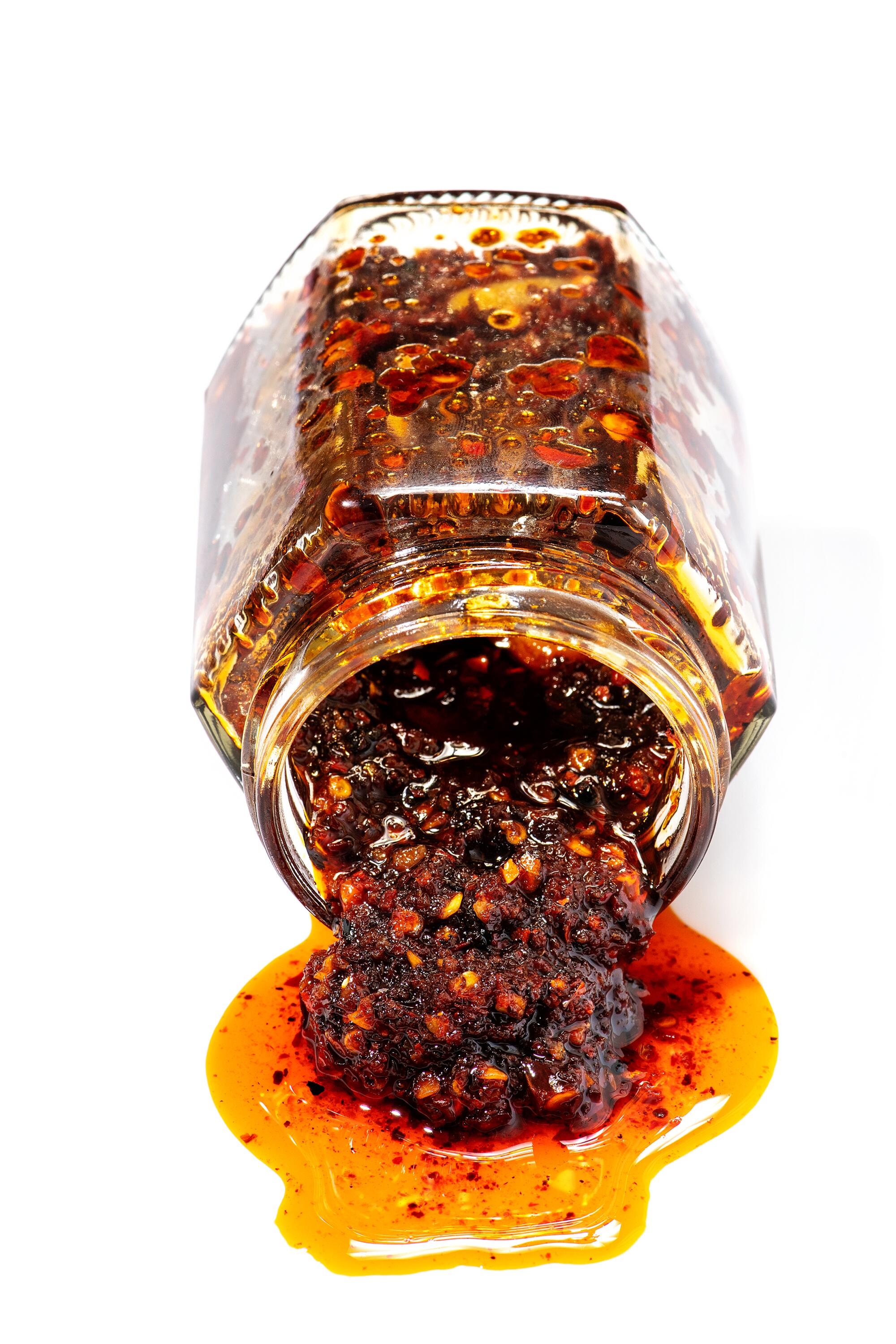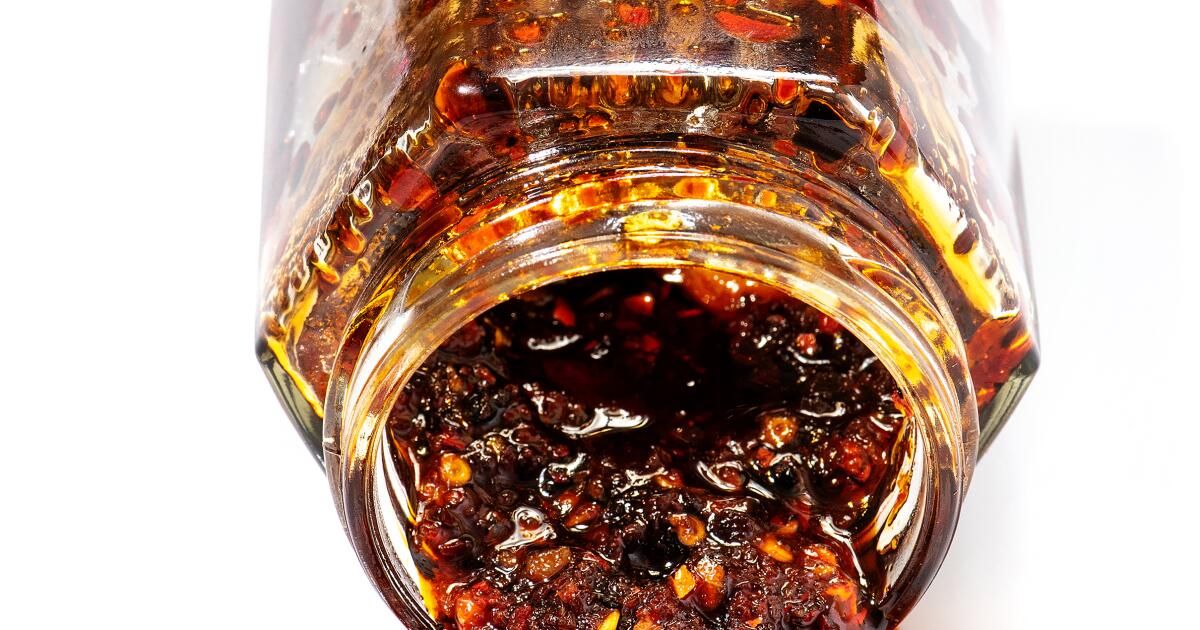Imagine walking into a grocery store and seeing just one brand of each item. Identical “Ketchup” squeeze bottles. The “mustard” of a company. A “Salsa” brand. The “hot sauce” from a single manufacturer. What a dull world that would be!
If Momofuku has its way, the only “Chili Crunch” on store shelves will carry the Momofuku name.
Momofuku, founded by chef David Chang, last year acquired the rights to use “chile crunch,” spelled with an “e,” from Chile Colonial LLC. a Denver company that registered the trademark in 2015 with the United States Patent and Trademark Office after making a Mexican-inspired crunchy chili sauce since 2008. Then, on March 29, Momofuku filed a trademark application for the term “chili crisp,” spelled with an “i,” and began sending cease-and-desist orders to multiple companies selling crispy chili products, The Guardian first reported.
A jar of Momofuku crispy chili.
(Mariah Tauger / Los Angeles Times)
The social media reaction immediately followed. Actor Simu Liu, chief content officer at MìLà, a food and beverage company that makes frozen dumplings and crispy chili, challenged Momofuku to a blind taste test on Twitter last week: “The winner gets the name, the loser (will keep the name). be you) back off.”
In a statement to The Times, a Momofuku spokesperson said the company has seen several chili crisp products rebranded as chili crisp over the past year, and that the brand was never intended to “stifle innovation in a category we care about.” deeply”.
“When we created our product, we wanted a name we could have and intentionally chose 'Chili Crunch' to further differentiate it from the broader chili crunch category,” the spokesperson wrote in an email. “We worked with a family business called Chile Colonial to buy the brand from them. “They have defended the brand before against companies like Trader Joe’s.”
One of the voices critical of Momofuku threatening legal action against other chili sauce companies was Fly by Jing chef and businessman Jing Gao. He began bottling Sichuan crispy chili in 2018 and is often credited with being the catalyst for the introduction of crispy chili. She is also an investor and advisor to Homiah, one of the brands that received a cease and desist letter.
Gao's own company, as reported by several media outlets, applied for the “Sichuan Chili Crisp” trademark in 2019, but its application was dismissed in 2020.
“The 'chili crunch' trademark should not have been granted either,” Gao wrote in a Substack newsletter titled “On Trademark Bullies.” “It's a descriptive term for a cultural product, one that has existed in Chinese cuisine for hundreds of years.”

A jar of Jing Gao's Fly by Jing Sichuan Chili Crisp. Gao is credited with starting the current chili sauce craze with the introduction of his crispy chili in 2018.
(Mariah Tauger / Los Angeles Times)
However, what the newsletter and other stories didn't mention is that last week, on April 3, Fly by Jing re-filed for the “Sichuan Chili Crisp” trademark, according to the U.S. Patent and Trade Office. Then on Monday, Gao said in a statement to the Times that he requested to withdraw the request.
Gao said Fly by Jing re-ordered “Sichuan Chili Crisp” as well as “Chengdu Crunch” “to protect us from the potential we need to defend ourselves from a greater power that may be threatened by our existence. However, in light of the events of the last two days, we now believe that enough awareness has been raised about the descriptive nature of the term that the USPTO will reconsider the chili/chili crunch trademarks, and we feel comfortable filing an application to abandon the application for the name of our product, which we already did since Saturday.”
“Even if we had been granted the Sichuan Chili Crisp trademark, which we have now abandoned, Fly By Jing would not have used it to bully small businesses,” Jing wrote.
However, if Fly by Jing had been granted a trademark, the company would be responsible for enforcing it, as outlined by the United States Patent and Trademark Office. By not protecting your brand, you could lose it.
If it were up to me, none of the terms would be trademarked.
David Tran, founder of Huy Fong Foods Sriracha sauce, never sought to exclusively own the term “Sriracha.” Instead, he trademarked the Rooster logo and bottle from it.
I reject the idea that anyone can exclusively own something so deeply rooted in my culture, a food that I consider an intrinsic part of my identity. These trademarks will limit who can benefit from a food related to entire cultures. It would be like someone trying to trademark salsa macha and salsa verde. Wait, someone inexplicably registered salsa verde as a trademark, indicating a serious problem with the USPTO's lack of knowledge to accurately or fairly determine what is descriptive or misleading when it comes to certain foods.
I, like many Chinese Americans, feel a sense of pride and ownership over the condiment that is typically made with garlic, other alliums, chilies, and oil. Whether you call it crunch, oil, crunch, or sauce, it's an integral condiment to the cuisines, cultures, and experiences of Asian Americans around the world.
Michelle Tew, founder and CEO of Homiah Foods, called receiving her cease-and-desist letter a “punch in the gut.”
“Homiah's Sambal Chili Crunch product is personal and based on a family recipe from my grandmother Nonie that dates back to countless generations of Nyonya heritage in Penang, Malaysia,” Tew wrote in a statement on LinkedIn. “I was shocked and disappointed that a well-known and respected actor in the Asian food industry would legally threaten me (a one-man show that operates on a much smaller scale) to sell a product that is part of my family's history and culture. “
The change to the “chili crispy” trademark, whether intentional or not, will only serve to whitewash an entire genre of chili sauces. Although some of the sauce companies have strong financial backing (according to Forbes, Momofuku raised $17.5 million in funding last year on $50 million in sales, MìLà recently raised $22.5 million, and Fly by Jing raised 12 million last year), many of these products are made by AAPI-owned small businesses.
Everyone deserves a piece of the more than $3 billion hot sauce industry in the United States. And that figure is expected to nearly double over the next decade, according to a market report from Fortune Business Insights.

A jar of chili sauce can be found on most tables at restaurants serving dumplings in the San Gabriel Valley.
(Mariah Tauger / Los Angeles Times)
Melody and Russ Stein's pizza company Pi00a (pronounced pie-oh-ah) started selling jars of chili crisps when they opened a ghost kitchen in Koreatown last year with their children, Taysia and Rylan. Pi00a is a family-owned, deaf business that sells Neapolitan pizzas with Asian influences and has a mission to provide employment for the hearing impaired.
For a soppressata pizza, Melody came up with her own version of crispy chili, something “sweet and spicy” that goes well with Italian dry salume, she said over the phone with her daughter interpreting. “People liked it and started asking for jars,” and Pi00a now sells about 100 jars a week through her online business and 40 retailers.
“We just started our small business and rebranding costs a lot of money. It is very difficult to absorb any additional expenses. we just wait [Momofuku] “They realize the impact this has on the community and abandon commercial brands.”
Kansas City chef James Chang, who makes his own crispy chili, wrote in an Instagram post referencing the cease-and-desist letters: “While I haven't received any yet, it's just a matter of time. …For someone who has criticized how the ethnic aisles of grocery stores don't have enough minority-owned brands. [David Chang] is doing exactly the same thing. Instead of creating a community, he wants to create a monopoly.”

A collection of chili oil, crunchy and crunchy.
(Mariah Tauger / Los Angeles Times)
You can find a jar of chili sauce that is half oil, half chili and garlic sediment on the tables of most restaurants that serve dumplings in the San Gabriel Valley. Many make the sauce themselves.
Before it was a trendy condiment found in every superette (and even Costco), there were half-empty jars of crispy Lao Gan Ma hot pepper with crust around the lids in my refrigerator and on my family's table. My Chinese grandmother and uncle introduced me to Lao Gan Ma Spicy Crispy Chili in the late '90s. It's a sludge-like combination of dried chilies, crunchy onions, MSG, and fermented soybeans. For years I called it chili crisp. I could never remember the name and just asked for more of that “crispy chili from the stern lady.”
The sauce was created by Tao Huabi in Guizhou, China, in 1984. His is the face of every bottle.
Almost a decade ago, I took Lao Gan Ma to a hot sauce tasting with the late Jonathan Gold and Kogi BBQ chef Roy Choi. The crispy chili with the stern lady on the bottle was the clear winner.
“Sauce invented by our ancestors, our version perfected for over 30 years…” the creators of Bowl Cut chili crisp wrote on Instagram. “No one should own a trademark for the description of a sauce that has been around forever.”
Crispy chili is for everyone.
Deputy Food Editor Betty Hallock contributed to this. report.












